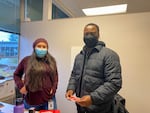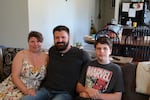On the last day of school this past June, Heidi Willis addressed her students for the final time as their math teacher.
“I am so, so proud of you, you know I am,” Willis said, looking out at a sea of tired freshmen in her David Douglas High School classroom.
“You guys worked super hard … especially considering the last full year of school you had was in sixth grade.”
Before she let the students go for the summer, Willis offered some advice for the soon-to-be sophomores.
“You come, you work, you ask questions, you get help, you can learn anything, you can do whatever you want, right? Whatever you’re willing to put the effort in for.”
Last year, students all over Oregon had to learn to do school all over again. How to make friends in a new place, how to bounce back from COVID-19 interruptions, and for ninth graders, how to navigate high school, where the academics only get tougher each year.

(Clockwise from top left) Ava, Leyna, Anais and Josh are heading into their sophomore year at David Douglas High School in Southeast Portland. The students in OPB’s Class Of 2025 reflected on 9th grade and what they're looking forward to in the new school year.
Kate McMahon / OPB
Education leaders look to ninth grade as a key marker — if a student passes their classes over the first year of high school, they are more likely to graduate. If they’re failing classes freshman year, it’s a big warning sign.
OPB has followed a group of 27 students since first grade, when they all attended Earl Boyles Elementary School in Southeast Portland. The Class of 2025 project started back in 2013, when Gov. John Kitzhaber set a goal that by 2025, 100% of Oregon’s students would finish high school. Nearly a decade later, that class is in 10th grade, amid an ongoing pandemic, trying to stay on course to earn a diploma.
While many students in OPB’s cohort have moved out of Portland, about half of them have moved through school together, and are now at David Douglas High, the largest school in the state. One student left partway through the year to attend an alternative high school.
Ninth grade was a big year for the Class of 2025. For some, it was the first full school year back in person and the beginning of the last leg of the journey to 2025: high school graduation.
Before heading into sophomore year, students and staff reflected on lessons from freshman year, as well as goals for 10th grade and for the future.
Students in OPB’s Class of 2025 are referenced by first name only to maintain privacy for students and their families.
“David Douglas Middle School”
The beginning of high school last year brought excitement and anxiety for students. Some had experience with the school and its teachers before through Ninth Grade Counts, a program to prepare students for high school.
“I’m kind of nervous because there’s a lot more kids than summer school, obviously, and good because I kind of, somewhat know the way around the school, because we did that tour,” said Anais, one of OPB’s Class Of 2025 students.
Armed with paper schedules for the day, incoming students toured their brand new school with the help of returning students.
“I’m kind of nervous with the classes and stuff,” said Ali.
The year started off with students wearing masks, a requirement from the school district.
“It’s been weird, you gotta wear a mask every day, everywhere you go,” Joel said of school during the pandemic.
“I like how people don’t get to see half of my face,’’ Leyna said. “It feels weird now… it feels like my face is naked without it.”
As the year started, students settled into their classes and graduation mentors Isabella McCarthy-Zelaya and Greg Carradine Jr. got to work. They each have a list of about 100 students that they work with one-on-one, students that need the most support coming to school, or succeeding academically.

Graduation mentors Isabella McCarthy-Zelaya and Greg Carradine Jr. work with students in need of extra support and one-on-one mentorship. They start working with students as freshmen and follow them through to graduation.
Elizabeth Miller / OPB
But the biggest thing the mentors noticed when school started was how behind students were socially.
“We were calling it ‘David Douglas Middle School’ at the beginning of the year because our ninth graders hadn’t been in class in person since middle school, and realistically, the 10th graders hadn’t either,” McCarthy-Zelaya said.
“Our underclassmen kind of felt like socially, developmentally, still in middle school. So it was a lot more conversation around not just adjusting back to being in person, but how do you adjust back to being in person in a brand new school?”
The mentors organize the students they’re helping into a three-tiered system: from tier one students who are doing well without support to tier three students who need multiple interventions. Graduation mentors focus the most on those tier three students and use regular progress reports to help them keep track of who needs the most help. The graduation mentors stay with individual students as they progress through high school. Even with a team of four mentors, the group can only get to about 500 students out of the almost 3,000 who attend David Douglas.
“Freshman year has been pretty bumpy,” Ali said, reflecting on the year. McCarthy-Zelaya was her graduation mentor.
“I don’t understand a lot about math, and I have trouble making friends, I’m not really social like that,” Ali said.
McCarthy-Zelaya and Carradine Jr. said students showed up to the school feeling overwhelmed. They helped ninth graders set attainable goals, and offered up their offices as a space for students to calm down if they needed a break. But most of all, they prioritized connecting the new students to adults at school, such as the mentors themselves.
“Just reassuring them, whatever you need, don’t hesitate to come to our office and let us know,” Carradine Jr. said. " … It’s not just about your academics, whatever you’re going through.”
Throughout the year, the graduation mentors send handwritten cards to families to celebrate student achievements with a “good news” card, or a “we miss you” card if they haven’t seen a student for a while.

Graduation mentors send cards to students they work with — to celebrate wins, but also to reach out if they haven’t seen students in a while.
Elizabeth Miller / OPB
By the middle of the year, students were still struggling academically. But Carradine Jr. and McCarthy-Zelaya saw a big change in the students they worked with: They felt comfortable speaking up, and talking to adults in the building.
“Maybe a lot of my students haven’t improved a ton academically, but what I have seen them improve in is their self-advocacy skills,” McCarthy-Zelaya said. " … They’re able to at least have someone to trust in the building, and it makes the school feel safer and more accessible to them.”
“More than anything, I just want them to know that there is an adult here to help them and support them,” agreed English teacher Jaclyn Stewart.
Math and attendance as on-track indicators
There is a data point education officials in Oregon use to predict whether students will graduate from high school on time. It’s called 9th Grade On-Track and measures the percentage of freshmen that have earned at least one quarter of the credits they need to graduate.
Before the pandemic, in Oregon and in the David Douglas School District, that number had been in the mid 80s. That dropped in the 2021 school year. The percentage of ninth graders on track to graduate statewide decreased to 74%. In David Douglas, it fell to 63%.
Counselor Sarah Hunt considers math the “number one” indicator that students are “off-track.” It’s a subject many in the Class of 2025 struggled with.
“Most of my classes are going pretty good except for math,” Kaylie said. “I’ve always kind of struggled in math, especially in middle school, and so I’m still trying to come back from that, and trying to get my math knowledge up.”
“The most challenging part [of this year] was definitely math, it’s been very hard,” another Class Of 2025 student, named Dude, said. “The difficult thing is, I think I’m not grasping it, really.”
“When it gets challenging, I’m still kind of clicking off sometimes,” Josh said about math. He said he zones out, or takes a break and doesn’t want to return to it.
Heidi Willis, the math teacher, understood that students might come to her ninth grade class with some gaps in their learning. The math department changed its curriculum, and instead of teaching four units each semester, Willis taught three, plus a “unit zero” that included some review from middle school.
“We narrowed it down to the most important to be successful moving on,” she said.

Students walk along the breezeway at David Douglas High School in Southeast Portland. About half of the students in OPB's Class Of 2025 project attend David Douglas, the largest high school in the state.
Kate McMahon/video still/OPB / OPB
Ninth grade math is “foundational,” Willis said, and it’s important for students to learn what they need in order to move on and succeed in 10th grade math. She said she had more ninth graders struggling in the past year.
The biggest obstacle to students succeeding in math was spotty attendance, Willis said.
“Attendance was rough this year, more so than I ever remember,” Willis said. “I just feel like they don’t have the stamina, like they run out of steam.”
Official attendance numbers haven’t been released for last year, but chronic absenteeism, or students missing more than 10% of school, increased at David Douglas. School leaders have brought back an attendance coordinator, a full time position based at the high school, to address attendance and support families.
Willis recalled a student who succeeded in her class and got good grades, but suddenly, stopped showing up near the end of the year. She talked to the student as it got close to the end of the year, and he said he overslept, and couldn’t get out of bed — but was able to return and take his final.
After distance learning, or a mix of in-person and virtual schooling, returning to school was tiring for some. She recalled other students who stopped showing up, and didn’t re-engage at all.
For students who may show up to school but fail to pass math freshman year, there are ways students can make it up, from after school credit recovery during the year to summer school.
In an effort to engage more students with math, the high school offered “robot algebra,” a hands-on math class.
For some students, the return to school has brought new behavior and reactions to being in school.
“Student issues have been amplified,” said English teacher Jaclyn Stewart.
“They want to be socializing the entire time. It’s like they’ve gone through social withdrawal. They’ve been so isolated at home and so all they want to do is socialize and it’s very hard to keep them quiet and focused,” she said.
Stewart also reports seeing a higher number of students that are anxious or depressed.
She said it’s changed how she taught over the year. More teachers incorporated social-emotional content into their curriculum, opportunities for students to connect schoolwork with what they were going through.
She taught the book “Speak”, about a girl who experiences a trauma. In class, Stewart talked with her students about mental health, PTSD, isolation, and how to deal with high school socially. She’s assigned journal writing assignments to students.
“I think that gives students a way to reflect and process what happened to them and where they want to be and that has really helped them,” Stewart said.
Like McCarthy-Zelaya and Carradine Jr., she opened her door to students and handed her personal phone number out to families. “It’s the relationships, I think, that contribute the most to their success,” Stewart said.
Ali said her friends and teachers made her want to come to school last year. She liked her teachers, but wishes school staff would have reached out to her more often to see how she was doing.
“The one thing I think the school could do better is just checking up on their students more, and make sure they’re OK so they do better at learning,” Ali said.
In addition to lessons that connect to life, the time back in school helped students readjust to routines and people again.
“As the year has gone on I think that they have gained friendships which has given them confidence,” Stewart said.
Like Stewart, counselor Sarah Hunt saw more social anxiety from students. But she also saw them enjoy ninth grade.
“‘I like school, I like being able to see my friends, I like being able to sit where I want at lunch, I like my teachers’… some of it is very, what we expect, with some variation,” Hunt said.
But despite the growth over the year, COVID continued to cast a shadow over any idea of “normalcy.” Students and staff were in and out of quarantine, testing positive for COVID-19 or staying at home due to exposure.
Jason is one of the students in OPB’s Class of 2025 project who has moved away from Portland. He wrapped up freshman year at Woodland High School in Southwest Washington. He got COVID second semester and missed a couple of weeks of school, which ended up hurting his grade in biology.
“It was really hard [to catch up],” Jason recalled. “I did most of the assignments that I missed, but … while I was doing those assignments he handed out more and I just couldn’t really catch back up all the way.”

Class of 2025 student Jason with his parents Tara and Jay at their home in Woodland, Wash. Jason is starting sophomore year at Woodland High School in Southwest Washington.
Elizabeth Miller / OPB
Jason and his parents say his grade improved after that, from an F to a C, but Jason has set higher standards for himself.
“My low is a B,” he said, referring to his grades before he got COVID.
Jason is looking forward to 10th grade and his astronomy and art classes.
“And I’m excited to be one year closer to not being in school,” he added.
Ending the year looking forward instead of back
Sometimes Kaylie likes to look at old pictures from the beginning of freshman year.
“I’ve definitely learned a few things coming to high school — not math and science and English wise, just more, life wise,” Kaylie said.
She’s met new people, and enjoyed going to football games. She’s also struggled in some of her classes.
“I always forget to do my homework,” she said.

Kaylie and the other Class of 2025 students are heading into their sophomore year. Since coming to high school, she said she's learned a few things "life wise."
Kate McMahon/Video still / OPB
This year, she took a theater class and got involved in the school’s drama program, working backstage for plays and musicals throughout the year. It’s something she plans to continue through the rest of high school.
Compared to online learning, Kaylie said being back to school in-person made it easier to make friends and pay attention in class.
This past year has demonstrated the value of in-person learning for Ava, too.
“I think it’s easier to get my work done and to actually participate,” Ava said. " I just feel more free. I think it’s been one of the best school years I’ve had in a while.”
Counselor Sarah Hunt wants the new sophomores to know that while freshman year counts, students can still finish high school on time even if they didn’t do well that first year. For students who passed all of their classes, it’s about continuing to build on that foundation.
“Let’s build from where we are, nobody is not going to make it … if you didn’t do great, let’s figure out how to do better, and always looking forward instead of back,” Hunt said.

One class Jason is looking forward to in sophomore year is art class. He enjoys drawing and painting. A recent creation of his merges Van Gogh’s painting “Starry Night” and “The Lord of the Rings”.
Elizabeth Miller / OPB
Statewide, Oregon is three years — and about 20 percentage points — away from its goal of a 100% graduation rate by 2025. Oregon’s 4-year graduation rate for the Class of 2021 was 80.6%. The state’s 5-year graduation rate is closer to 100%, at 84.5%. Using the state’s broader “completer” rate, which includes GEDs, would get Oregon even closer, to a graduation rate just short of 88%.
Mike Costello teaches digital literacy at David Douglas, a class to help freshmen get acquainted with high school and develop good habits for the year.
“It’s a great goal, and every kid needs to graduate, needs to go to school,” said Mike Costello. “But if we’re talking realistically, it’s not going to happen.”
Before the pandemic, David Douglas High School’s graduation rate goal was 83% — and the school cleared that target in 2020. But the most recent grad rate, for the Class of 2021, was 75%, a steep drop from the previous year. Counselor Hunt expects that when graduation numbers are released for the Class of 2022, it will show an increase, and the school will update its goal accordingly.
“Our data shows that a 2% annual increase is a reasonable goal,” Hunt said in an email to OPB.
For the Class of 2025, another new school year is underway. And with that, the students are one year closer to graduation.
“When I think too far ahead, it kind of scares me,” Kaylie said. “Because I don’t know what I’m going to do. But when I think about junior year, and sophomore year, I get kind of excited, because I’m really excited to see what more I know then, and what I learn.”




